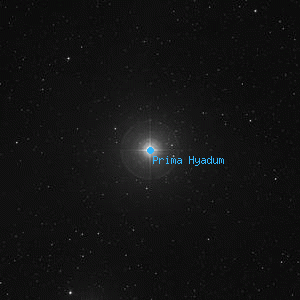Prima Hyadum

Overlaid DSS image of Prima Hyadum, 60' x 60' with north at top and west to the right
Aladin viewer for the region around Prima Hyadum
Hyadum I, Gamma Tauri, γ Tau, 54 Tauri, 54 Tau
BD+15 612, HD 27371, HR 1346, WDS J04198+1538, SAO 93868, GSC 01264-01009, HIP 20205
BD+15 612, HD 27371, HR 1346, WDS J04198+1538, SAO 93868, GSC 01264-01009, HIP 20205
| Type | Star |
|---|---|
| Magnitude | 3.65 | Right Ascension | 4h 19' 47.6" (2000) |
| Declination | 15° 37' 39" N |
| Constellation | Taurus |
| Classification | G9.5IIIabCN0.5 |
Observing Notes
Andrew Cooper
Sep 12, 2023 Waikoloa, HI (map)
20cm f/6 Newtonian, Cave Astrola @ 76x
Seeing: 6 Transparency: 6 Moon: 0%
Brillian rich yellow, no companion noted, one of the primary stars of the Hyades
Captain William Henry Smyth
Nov 10, 1832 No. 6 The Crescent, Bedford, England (map)
150mm f/17.6 refractor by Tully 1827
A bright star with a distant telescopic companion, in the Bull's nostril. A 3½, fine yellow; B 11, pale blue, preceded by another small star in the sp quadrant.
This is Hyadum primus, or the leader of the Hyades, which, as the name implies, was esteemed a showery group; whence the pluviasque Hyadas of Virgil, and the moist daughters of Spenser. The family of Atlas was mentioned at η Tauri, but the Hyades were considered to be another batch of his daughters; though some, to lessen his burthen, dubbed them the Dodonides, or nurses of Bacchus.
The ancients were not agreed as to their number, for while Thales merely reckoned the two eyes, α and ε, Euripides counted three, and Hesiod five. Though the identity of this star must be pretty well established, it may be stated, that it lies about one-third of the distance from the Pleiades to the cluster in Orion's sword. But we learn from the poetaster that this direction is almost needless; forAmong those gorgeous hosts aloftPliny gives the name Palilicium to the Hyades, while others have made it proper to Aldebaran, because they rose heretofore at Rome, on the feast day of Pales; and Ovid lumps them together as Sidus Hyantis. The group was also called Y-psilon—the Pythagorean symbol of human life—from its shape; and from thence the Roman V, α and ε being the extremes, and γ the angular point.
so gloriously shown,
The Hyades, and Pleiades,
to all who seek are known.
From a notion, either that the same letter resembles a pig's jaws, or that Aldebaran with the Hyades were like a sow with her litter, the Latins designated them Suculæ. Cicero, however, thinks the name a corruption, from having mistaken the Greek word νεs, pigs, for νειν, to rain. It must not be forgotten that γ Tauri has a very appreciable proper motion in the awful void, the amount of which is thus severally given:P.... RA +0".14 Dec. -0".09
Br... +0".25 -0".10
B.... +0".18 -0".02
[Hipparcos +0".11546 -0".02342]― A Cycle of Celestial Objects Vol II, The Bedford Catalogue, William Henry Smyth, 1844
Other Data Sources for Prima Hyadum
Nearby objects for Prima Hyadum
13 objects found within 120'
| 48 Tauri | 55 Tauri | 58 Tauri |
| 60 Tauri | 63 Tauri | 70 Tauri |
| 71 Tauri | Delta2 Tauri | h Tauri |
| HD 26748 | Hyades | |
| Secunda Hyadum |
Credits...
Drawings, descriptions, and CCD photos are copyright Andrew Cooper unless otherwise noted, no usage without permission.
A complete list of credits and sources can be found on the about page
Prima Hyadum